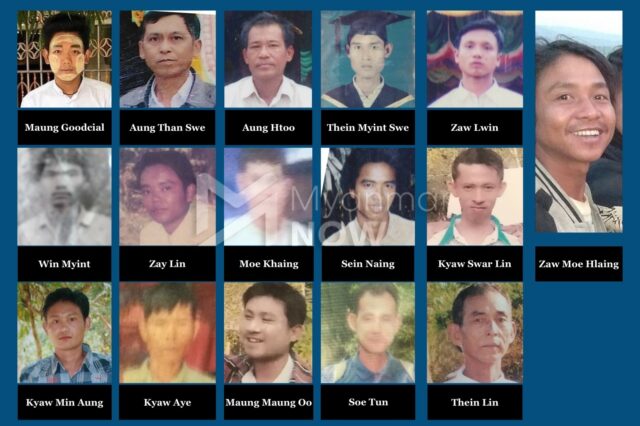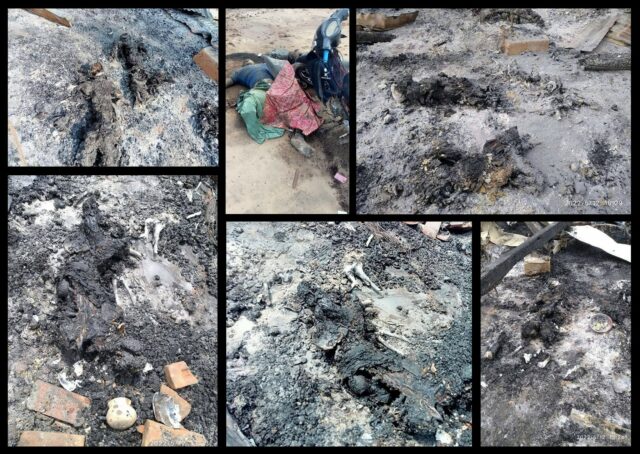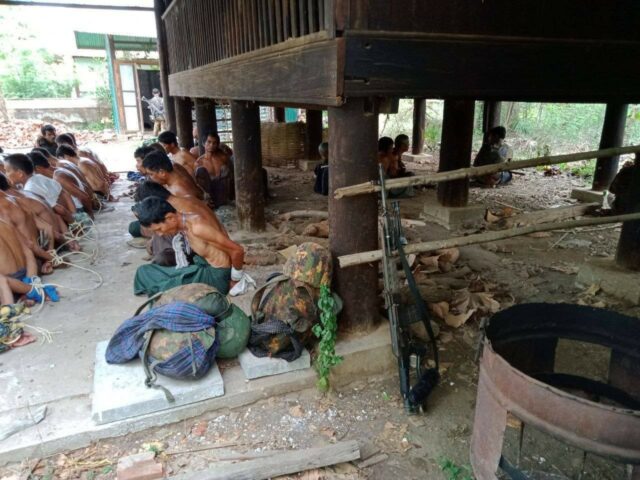Survivors haunted by Myanmar army massacre in Sagaing


Sixteen of the victims of the Mone Taing Pin massacre (Supplied)
Eyewitnesses to the brutal killing of 28 civilians in Ye-U Township recall a junta attack that was found to have been documented by the soldiers themselves
By Myanmar Now
No one will stay in the eastern parts of Mone Taing Pin anymore, where locals claim that dogs howl without provocation, putrid odours materialise and vanish, and shadowy figures are spotted only to disappear before they can be identified.
In May, the military massacred nearly 30 people in this village in Sagaing Region’s Ye-U Township. Though the victims’ remains have since been cremated and buried, survivors believe, in accordance with Buddhist custom, that their souls cannot transition into the afterlife until certain religious rituals have been performed.
Due to continued Myanmar army attacks, the living have been unable to make offerings to monks to share the karmic energy that would guide their loved ones to the next realm.
Once a sceptic of such practices, Mone Taing Pin villager Ko Linn* said he now believes that the ceremony is necessary, speculating that bone fragments of the victims found in homes burned by junta troops may be binding the spirits of the deceased to the location.
“We are planning to make donations in the name of the victims so that their spirits can cross over,” Ko Linn explained. “We will also invite monks to pray for the village and we will spread consecrated sand all over.”
More than 100 locals were initially detained during a May 10 military raid on the 400-household Mone Taing Pin, following an attack by a local defence force on a junta column outside the village that morning.
Twenty-eight of the captives, all men aged 20 to 60, were later found to have been killed. Three local resistance fighters were also shot dead, bringing the total number of those slain at the site to 31.
Myanmar Now conducted interviews with five survivors of the attack.
Fifty-year-old Thin Kyi hid in Mone Taing Pin’s monastic library with her husband, Thein Aung, when soldiers opened fire on the village with guns and artillery on the morning of May 10.
She recalled bullets hitting the walls around them, and troops entering the compound soon after, capturing the 100 people who had sought refuge on the religious grounds. They separated some 30 men from the women, tying their hands with rope, questioning and beating them.
The remaining women, of whom there were more than 70, were held for three days without food, another survivor said.
The soldiers released eight elderly men, including U Myint, who described to Myanmar Now the interrogations that took place.
“They wanted us to say that we were funding the PDF,” he said, referring to the People’s Defence Force, the armed wing of the civilian National Unity Government (NUG). “They asked us where the PDF stayed, and how many PDF members were in the village. We got beaten when we didn’t know the answers.”
Ten of the men who were detained were killed on May 10, and 18 more the following morning, he said.
“They had their hands tied behind their backs and were blindfolded,” U Myint added.
He escaped with seven other men after the military left Mone Taing Pin on May 12. The soldiers reportedly took three monks from the village with them as hostages.

The charred remains of victims of the massacre found in the houses in the eastern part of Mone Taing Pin village (Supplied)
Thein Aung, Thin Kyi’s husband, was last seen being taken away by the soldiers from the monastery.
“Run if you see them, or else you will face the same fate my husband did. They burned him alive,” she said.
Now a widow raising three children, she told Myanmar Now that she did not expect she would ever fully recover from the trauma of losing her husband and neighbours to the junta’s violence.
“Don’t ask me if I hate the military. I will make sure to teach my children to burn with hate upon hearing the word ‘military,’” she said.
Visual evidence emerges
RFA published photographic and video evidence on June 17 of the military committing atrocities in a location later determined to likely be Mone Taing Pin. The cache of more than 100 photos and video clips was reportedly found by a villager on a phone in Ayadaw Township, south of Ye-U, and subsequently turned over to RFA. It is believed to have belonged to a Myanmar army soldier involved in raids in the area.
A revolutionary force in Sagaing also sent the same files to Myanmar Now on June 23.
In the now widely seen video footage, three soldiers are seen filming themselves discussing how many people they have killed, and the manner in which they dismembered their victims.
“I’m an expert in killing,” one of the men—assumed to be the phone’s owner—is heard saying.
Among the photos recovered from the phone was an image, dated May 10, of around 30 men sitting with their hands tied behind their backs in front of a wooden building, guarded by three junta soldiers.
U Win*, a 45-year-old man from Mone Taing Pin, told Myanmar Now that the photo was taken in the village’s monastery, as RFA also suggested.
“I can identify all of the people in the photo. Of all of them, I think only one survived. The rest were all killed,” he said.

Villagers seen being held captive by the military in what is believed to be the Mon Taing Pin monastery (Supplied)
Other photos, including one from the following day, show the soldiers standing over bloody bodies, some of which belonged to men who RFA sources identified as being present in the earlier photo of captives in the monastery.
The bodies of those killed were later burned in houses in the village, they said.
Myanmar Now previously reported that some 30 homes were torched in Mone Taing Pin during the raid, and that it appeared that the bodies of those found inside belonged to victims who had been murdered before they were burned.
“There was blood in the front of the houses, so it looks like they were killed outside and then dragged inside and set on fire,” a villager told Myanmar Now at the time.
RFA contacted the junta spokesperson Gen Zaw Min Tun regarding the evidence, but he declined to comment until the military had carried out its own investigation into the incident.
*Some names have been changed to protect the safety of the individuals
Original Post: Myanmar Now

